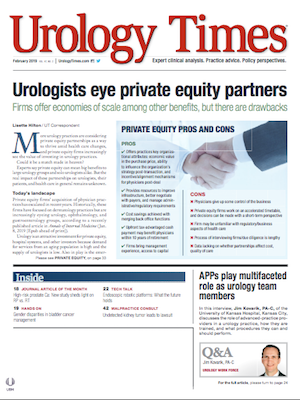Publication
Article
Urology Times Journal
2019 ‘to-do list’: Reduce debt, contribute to retirement plans
Author(s):
Include disability insurance and estate planning on your financial checklist for this year, advises Jeff Witz, CFP.
My New Year’s resolution was to get my financial house in better order. Where is a good starting point?
While not comprehensive, here is a checklist to get you started. There are certain to be other items you will want to address, but getting these financial items in place is a good start.
Set short- and long-term financial goals. Whether you want to be debt-free in 10 years or own a home in 5, you are more inclined to save if you have specific goals. Factor these goals into a budget and figure out where you can squeeze the extra money from to make these goals realities.
Budgeting. Every effective financial plan starts with a budget. Identify necessary spending and savings items. Give yourself a little leeway but stick close to the guidelines you’ve created throughout 2019.
Also by Jeff Witz, CFP - How to make sense of the IRA aggregation rule
Emergency funds. We have seen clients saved by their emergency funds numerous times. A sudden job loss, major surprise expense, or unexpected health issue can change your financial picture quickly. The general rule of thumb is to maintain an emergency fund equal to three to six times your monthly living expenses.
Debt reduction. Some forms of debt such as a mortgage on a house may be perfectly acceptable due to the tax deductibility of the interest. However, you should do your best to reduce your other debt, especially if you are paying interest at relatively high rates such as those on credit cards.
Retirement plan contributions. If you already contribute to an employer plan such as a 401(k) or 403(b), keep it going. The IRS increased the contribution amount for 2019 to $19,000 ($25,000 if over age 50). 401(k)s and 403(b)s should be maxed out before utilizing other tax-advantaged retirement accounts because they are protected by federal law from malpractice lawsuits and creditors. If you own your practice, determine if you are utilizing the best type of retirement plan for your specific situation.
Next:Traditional and Roth IRAs, disability and life insuranceTraditional and Roth IRAs. If you are already maxing out employer provided retirement accounts and wish to save additional amounts toward retirement, consider contributing to a traditional or Roth IRA. These accounts also offer excellent tax-advantaged growth and are protected in most states from malpractice lawsuits. The contribution limit increased to $6,000 per year for 2019 ($7,000 if over age 50).
Disability and life insurance. Often overlooked, disability and life insurance are actually very important components of financial security. Disability insurance supplements a portion of your income in the event you are sick or disabled and unable to work. In the event of a long-term disability, it could ensure you stay in your home and/or are still able to save for financial goals like retirement. All eligible physicians should have comprehensive disability coverage.
Life insurance is slightly more situational, but if you own a home with a mortgage or have any other debts that would not be absolved at your death, have children whose college educations you would want to guarantee, or have an individual or organization you would want to provide for in the event of your death, then life insurance should be considered.
Read - Flexible spending vs. health savings accounts: How to choose
Estate planning. The complexity of an estate plan may vary based on your assets and needs, but having basic estate planning strategies in place is important. Work with an estate planning attorney to review whether you need wills, powers of attorney, trusts, etc.
These are important items to have in place and will give you a good foundation to start moving toward a financially secure future. I recommend speaking with your financial adviser about other areas that could use improvement.
Is there anything I can do at the beginning of the year to prepare my investments for the year ahead?
Assuming you have an investment strategy in place that includes an asset allocation mix that is appropriate based on your risk and return objectives and you have investments that fit into these asset classes, then a good item to review at the beginning of the year is portfolio rebalancing. Over the course of the past year, certain asset classes will have outperformed, and others will have underperformed. That may have caused the asset classes to stray from their target percentages.
Your portfolio is a moving target that you must keep an eye on. If an asset class has moved too far away from its target, then rebalancing the portfolio and getting it back in line to start the year is a good idea.
Mr. Witz is educational program director at MEDIQUS Asset Advisors, Inc. in Chicago. He welcome readers’ questions and can be reached at 800-883-8555 or witz@mediqus.com.
The information in this column is designed to be authoritative. The publisher is not engaged in rendering legal, investment, or tax advice.

Newsletter
Stay current with the latest urology news and practice-changing insights — sign up now for the essential updates every urologist needs.




















